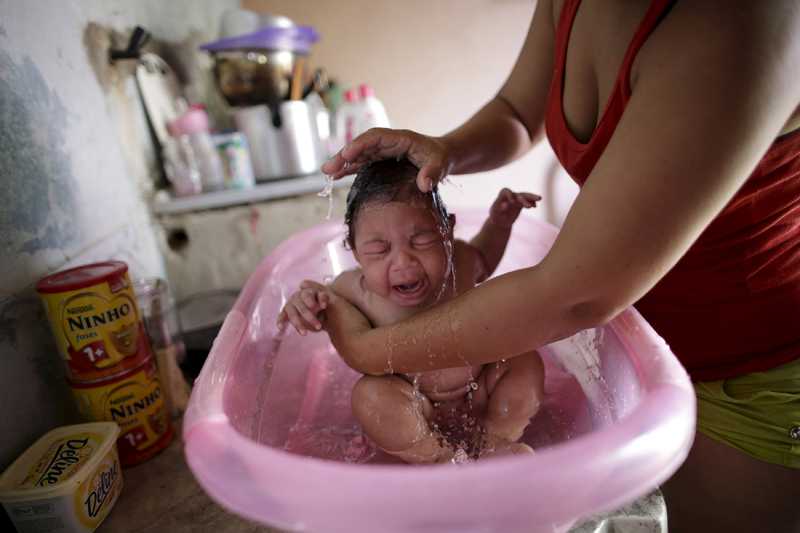Mosquito-packed drones could give extra bite to Zika fight
27 January, 2018

Rosana Vieira Alves bathes her 4-month-old daughter Luana Vieira, who was born with microcephaly, at their home in Olinda, Brazil, in this file photo taken February 4, 2016. Photo: Reuters
Spraying thousands of chilled, sterile mosquitoes from specially adapted drones could prove a cost-effective way to slash numbers of the insects and curb the spread of Zika and other mosquito-borne diseases, say the backers of the technology.
WeRobotics, a non-profit trialling the method, plans to start mosquito-release tests shortly in Latin America.
It has recently piloted ways to transport medicines and medical samples in Peru’s Amazon region and the Dominican Republic using the unmanned aerial vehicles. But this time the cargo will be sensitive insects that must survive the process.
“It makes no sense to release mosquitoes that are 90 percent dead or damaged – we need to make sure the quality of the mosquito is very high so they can compete for females,” said drone maker Adam Klaptocz, co-founder of WeRobotics, which is based in Switzerland and the United States.
“The ultimate goal is to integrate drones into future vector control campaigns,” he told the Thomson Reuters Foundation.
Mosquito-control programmes using sterile insects often rely on trucks to disperse the bugs, or people releasing them from backpacks. Both of these are time-consuming methods unsuited to hard-to-reach places.
With aerial dissemination, the sterilised insects must be cooled down before they are packed into the container of the drone which would then expel them at altitude, said Klaptocz.
In the trial, the mosquitoes will be marked, trapped and inspected to see how they fare and how far they are dispersed, he said. The drones cost around $5,000 each.
If successfully released, the sterile male Aedes aegypti mosquitoes would compete with wild insects to breed with females, eventually suppressing numbers and helping stop the spread of diseases including Zika, Klaptocz explained.
Pregnant women infected with Zika risk having babies with the birth defect microcephaly, which is defined by an unusually small head and can result in developmental problems and other severe brain abnormalities.
The Zika epidemic that hit Brazil in 2015 affected thousands of babies.
Usually found in urban and semi-urban areas, the Aedes aegypti mosquito also transmits dengue, chikungunya and yellow fever.
Two or three drones could control mosquitoes across an entire city, replacing a few hundred trucks and the staff needed to run the operation, Klaptocz said.
“It’s beneficial to a larger population if you have this (drone) technology,” he said.
WeRobotics, which is working with the US development agency USAID and the International Atomic Energy Agency (IAEA), is awaiting final approval for its upcoming drone test, before announcing where it will be held, he added.
ASK FIRST
Besides legal permission, a local laboratory is needed to sterilise the insects using radiation. Obtaining community “buy in” is also key, by explaining the method to local leaders and health authorities, said Klaptocz.
“You never go in, fly drones, drop mosquitoes and ask questions later,” he said. “It’s not about technology, it’s not about drones; it’s about people getting less sick – and that’s very understood by communities.”
Repeatedly blitzing an area with sterile mosquitoes could help suppress populations within months, said experts.
When sterile males are introduced, “they’re like little heat-seeking missiles, looking for females that will then induce a population crash,” said Conor McMeniman, assistant professor at the John Hopkins Bloomberg School of Public Health, who is not involved in the project.
Releasing sterile insects has previously helped suppress pests including fruit and tetse flies, said the IAEA, which is also working with the U.N. Food and Agriculture Organization to reduce malaria with sterile Anopheles mosquitoes.
But the drone method would need to be combined with other controls such as fumigation and stagnant water removal, as the Aedes aegypti can lay its eggs in any sources of standing water, from used car tyres to rubbish and even soda-bottle caps, said McMeniman.
BLOOD TESTS
Aside from mosquito dispersal, drones have huge potential to help people living in remote places with limited access to hospitals, said Klaptocz of WeRobotics.
In Peru’s Amazon region, recent trials have used drones to fly supplies – including anti-venom for snake bites – to isolated communities, and transport blood samples from patients who would otherwise have to travel hours by river to hospital.
“If instead you could take their blood, put it in a drone and then send it to a hospital 50 km (30 miles) away, it gets there in an hour, the blood gets tested (and) the results get sent back by SMS,” said Klaptocz.
In the Dominican Republic, WeRobotics and its local partners have used drones to test deliveries of medical supplies.
Elsewhere, the unmanned craft have mapped and identified disaster-prone parts of Haiti, Nepal and Tanzania.
Training local pilots is essential to the long-term viability of any drone programme, said Klaptocz.
“We’re very focused on technology that makes sense and lasts beyond the end of our project,” he added.
